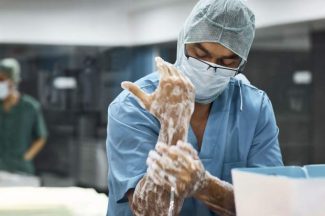Both patients and surgeons worry about infections occurring after surgery. Fortunately, the risk of infection following orthopedic surgery performed in the Vail Valley is about 0.3 percent.
This risk is about 1 percent in several Denver area hospitals. However, our hospitals, surgical centers and surgeons cannot take all the credit for achieving lower rates of surgical site infections here in the mountains. Instead, most of the credit goes to you, the patient. Our patients are healthier in general than many of the patients who have surgery in Denver.
Across the U.S., it is estimated that 35,000 surgical site infections occur after orthopaedic surgery. Over half of these infections occur in patients who have had joint replacement surgery. Surgical site infections are very hard on the patient as they increase a patients length of stay in the hospital by seven to 14 days, one may be required to stay in the intensive care unit and an SSI increases the cost of the surgical procedure by over 300 percent.
PREVENTION METHODS FOR PATIENTS
There are patient-specific factors that are both modifiable and nonmodifiable that place a patient at increased risk for infection. These factors include obesity, smoking, diabetes, rheumatoid arthritis, having a low red blood cell count and being a nasal carrier of the bacteria Staphylococcus aureus.
Patients should be encouraged to modify any of these risk factors prior to surgery if and when possible. In my clinic, we screen surgical patients for Staphylococcus aureus by swabbing their nose prior to surgery. The swab is sent to the lab, and if this swab reveals that the patient is a carrier for S. aureus, then we postpone their surgery and first treat them with antibiotics to clear the bacteria from their noses.
In orthopedic surgery, Staphylococcus aureus is the most common cause of SSIs. Treating carriers of S. aureus with antibiotics in this way has been shown to reduce the incidence of infection after surgery.
Prior to surgery, we also encourage patients to bathe with chlorhexidine soap. Doing so reduces the burden of bacteria that we all naturally carry on our skin. The studies have not clearly shown that this decreases SSIs when compared to using regular soap, but chlorhexidine was shown to be more effective at preventing wound infections than not bathing at all.
PREVENTION IN THE OPERATING ROOM
In the operating room, we do several things that decrease the chances of infection.
We shave the surgical site to remove body hair that may harbor bacteria and this in turn allows us to better sterilize the skin with an agent such as chlorhexidine or povidine-iodine, which kills the bacteria that we all naturally carry on our skin.
Surgeons and their assistants scrub their hands with the same bacteria killing agents used to sterilize a patient’s skin. Sterile drapes are carefully placed around the surgical site to protect the site from contamination. Patients are also given a single dose of antibiotics within one hour of making the surgical incision.
We do not use antibiotics for long periods of time after surgery when the site is deemed sterile so as not to select out for resistant and more dangerous bacteria that could cause a more serious infection. Our operating rooms have advanced ventilation systems.
Finally, sterile, occlusive dressings are placed on the surgical site at the conclusion of surgery to protect the wound until it appropriately seals in 48-72 hours.

